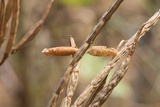Coleophora coronillae Zeller, 1849 Species
Last modified: Nov. 27, 2025, 8:13 p.m.
First record for this species was in 2016 in LI. Still a very rare species and hitherto known from 3 provinces in Belgium.
Details
- Classification
- Family: Coleophoridae > Genus: Coleophora > Species: Coleophora coronillae
- Vernacular names
- Zwavelgele peulkokermot (NL), Kronwicken-Sackmotte (DE)
- First mention in Belgium
- Wullaert S. 2017b. Resultaten van de Werkgroep Bladmineerders uit 2016 met meldingen van minerende en andere zeldzame Lepidoptera in België en met 5 nieuwe soorten voor de Belgische fauna (Coleophoridae, Tortricidae, Gelechiidae en Nepticulidae). — Phegea 45(3): 79–96. On page 83. view page
- Status
-
Native
Distribution
Caterpillar
The larva makes small mines to build the case, or it lives in a seed pod.
Case
The caterpillar builts a two-valved tubular case, the mouth angle is about 45°.
See also bladmineerders.be.
Bionomics
The caterpillar feeds on the seeds. In the past there was a lot of confusion with Coleophora oriolella Zeller, 1849, therefore it is still a discussion about what exactly the food plants are…
Notes from Dr. W. Ellis in Parasites of Europe: “In the literature before the publication by Patzak (1974a) mostly it is stated incorrectly that the larva would live in a lobe case. In any case, the illustrations and descriptions by Hering (1957a), Toll (1962a), and Razowski (1990a) do not relate to C. coronillae; it is conceivable that they actually refer to C. oriolella. Faunistical and biological information about coronillae should be treated cautionary, therefore. In particular, it remains to be seen if the species lives on other host plants than Securigera (Coronilla). Baldizzone (2004a) describes the case as lightly colored; the larva should live on the pods.
Flight periods
The adults are on the wing from early June till late July.
Observed on
- Host plant (species):
- Coronilla varia
- Host plant (genera):
- Astragalus, Lathyrus and Coronilla
The larvae feeds on Securigera (Coronilla) varia. Possible but not at all sure also on Astragalus glycyphyllos and Lathyrus.








